
In the rich landscape of the American Southwest, Native jewelry shines as brightly as the desert sun. Here, jewelry transcends the realm of adornment to a personal expression of heritage by artists who call this magical place home.
Within this cultural and artistic tapestry, textile artist Naiomi Glasses finds herself drawn toward jewelry to accentuate her iconic másáni-style outfits, a modern interpretation of Navajo fashion dating back to the 1910s. Naiomi’s style regularly features handmade three-tiered Navajo skirts, refined button-down shirts, cowboy boots, and the signature Diné (Navajo) hairstyle, the tsiiyééł. Each outfit is only complete after a careful selection of unparalleled museum-quality jewelry, pieces resonating profoundly with Naiomi’s values and style.
Naiomi Glasses is a weaver and a champion for burgeoning talents in the Southwest. The jewelry she covets is not found in high-street stores. They are intricate narratives told through silver, gold, and beautiful semiprecious stones.
With each acquisition, she supports the careers of exceptionally talented artists and encourages others to do the same. Her journey, much like the jewelry she treasures, is a reflection of the deep connection between art, family, legacy, and identity in the Southwest.
As the first artist in residence at Ralph Lauren, Naiomi embraced the invitation to fully celebrate her creative and personal style. The Artist in Residence program furthers Ralph Lauren’s efforts to shift from being “inspired by” to collaborating with the communities that influence its designs. The program invites artisans to create a product collaboration with Ralph Lauren’s design teams in a mutually beneficial exchange, combining the unique skill of the artisan with the brand’s core sensibilities. The residency provided Glasses with the opportunity to create a collaborative ready-to-wear collection and the autonomy to weave her artistic vision into an entire collection.
Central to this vision is her belief: No outfit is truly complete without turquoise. “My collection had to spotlight authentic, premier Native American jewelry and tell the stories of the artists behind them.” While New Mexico and Arizona are home to numerous sovereign tribal nations, this collaboration primarily highlights the unparalleled craftsmanship of artists from the Navajo Nation, San Felipe Pueblo, Zuni Pueblo, and Hopi Pueblo.
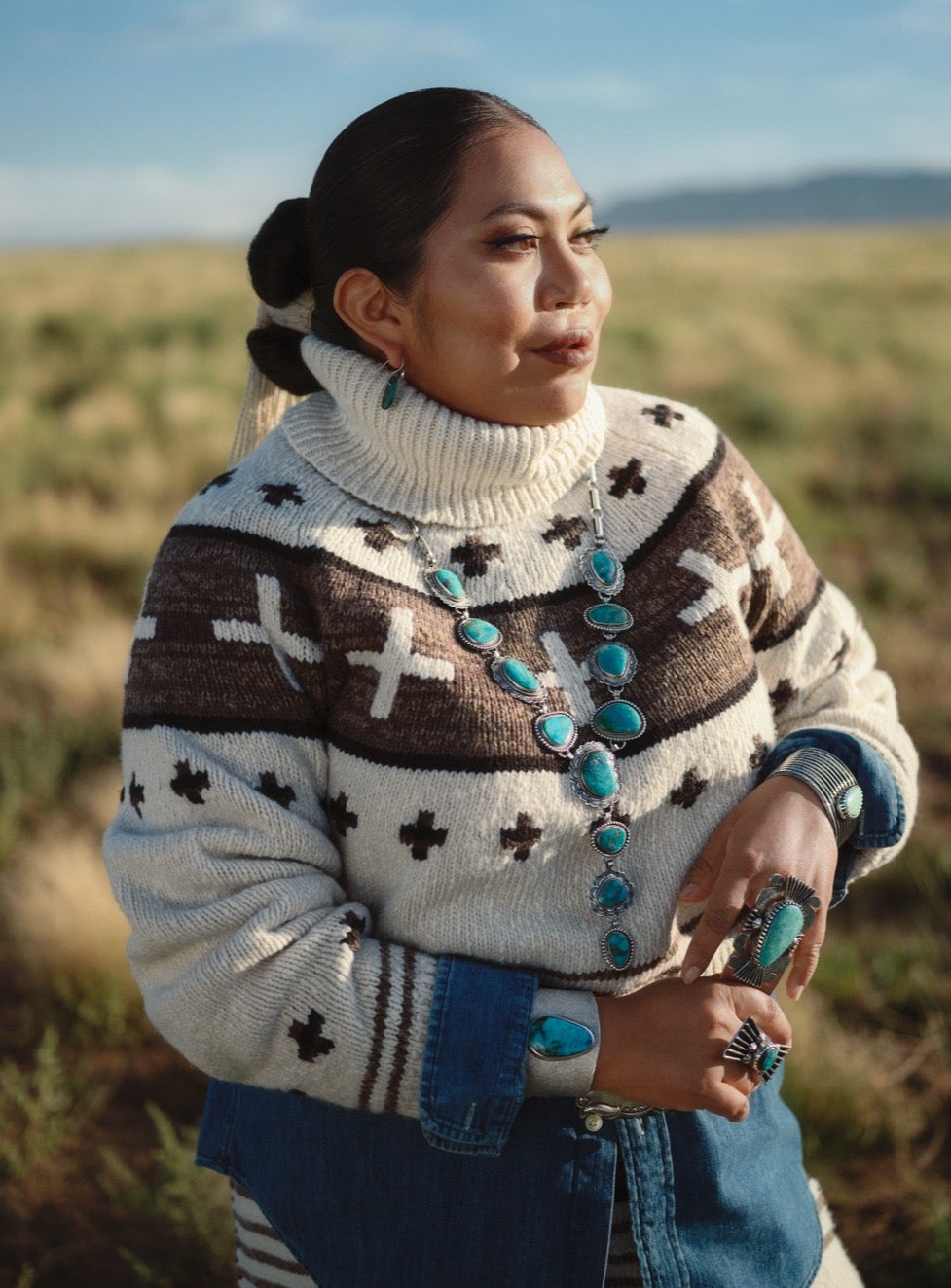
A seventh-generation Diné (Navajo) textile artist, designer, and model. After moving from Phoenix, Arizona, to Dinétah (Navajo Nation) during her childhood, Naiomi began intensively studying traditional weaving under her grandmother. Now 26, Naiomi is regularly featured at SWAIA’s Santa Fe Indian Market and Heard Guild Indian Fair & Market, where her work has earned a range of awards and acclaim, including multiple ribbons in both textile categories and weaving divisions
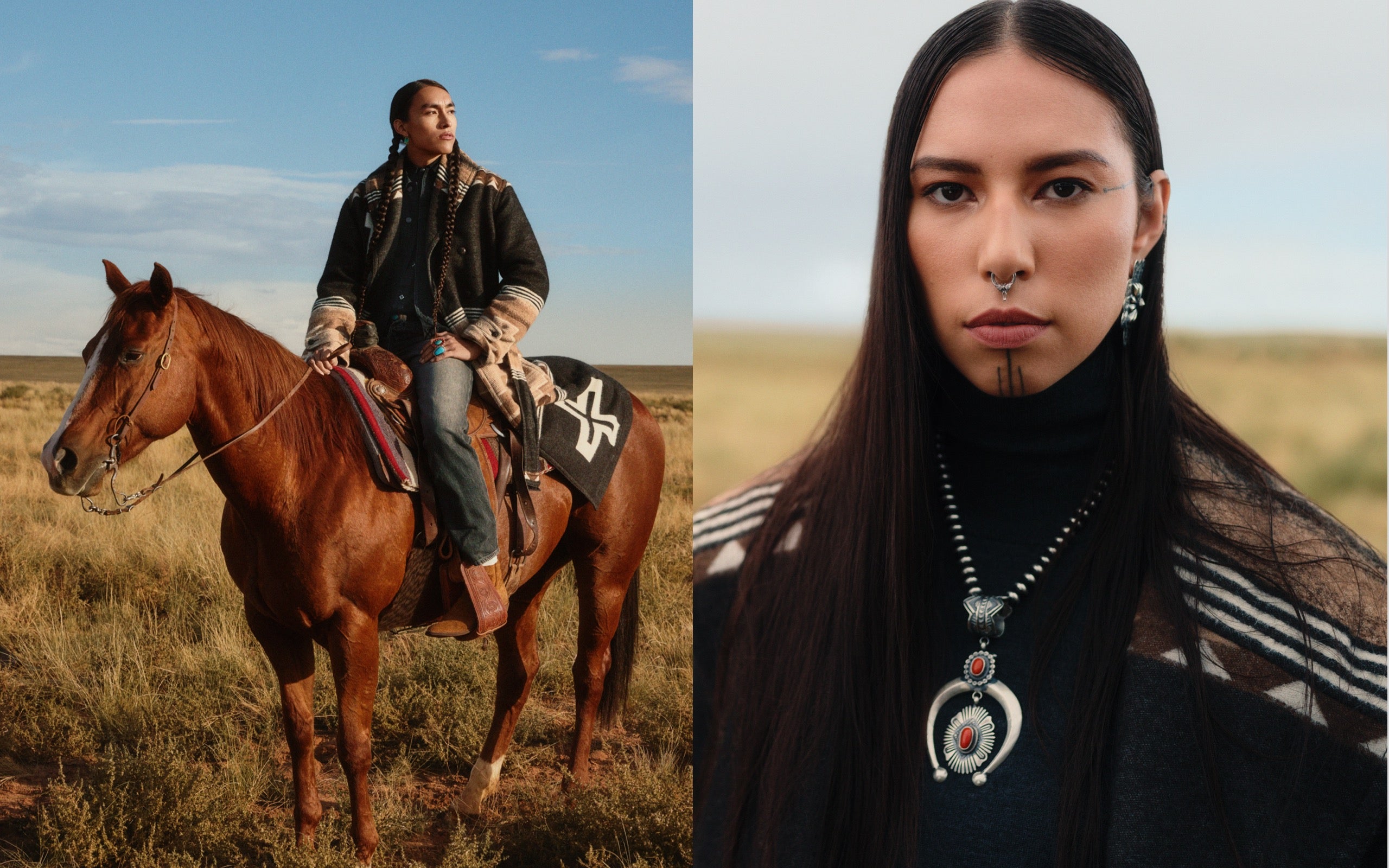
Polo Ralph Lauren x Naiomi Glasses, the inaugural collaboration for the Ralph Lauren Artist in Residence program, honors Navajo heritage and centuries-old wearing traditions
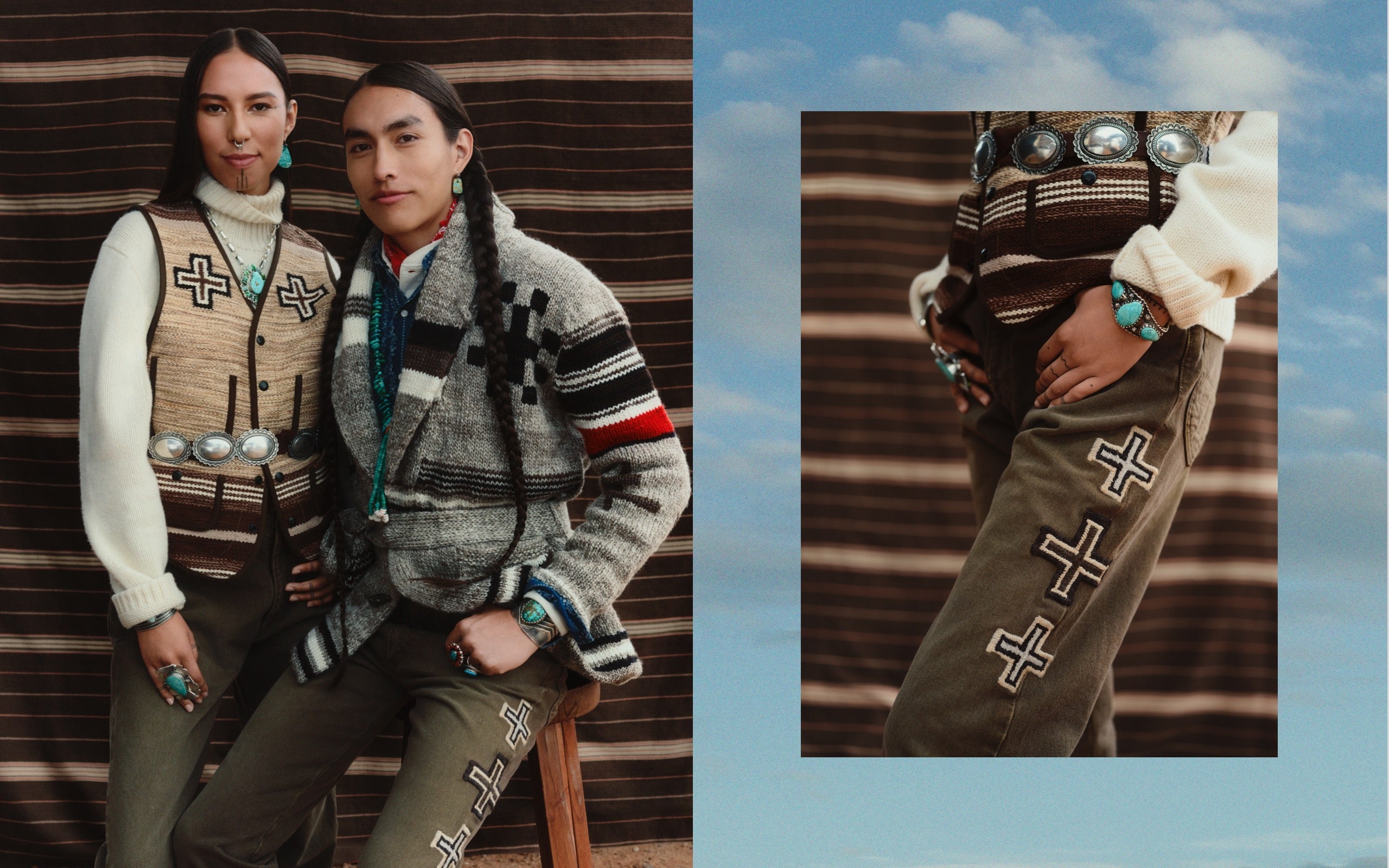
Polo Ralph Lauren x Naiomi Glasses, the inaugural collaboration for the Ralph Lauren Artist in Residence program, honors Navajo heritage and centuries-old wearing traditions
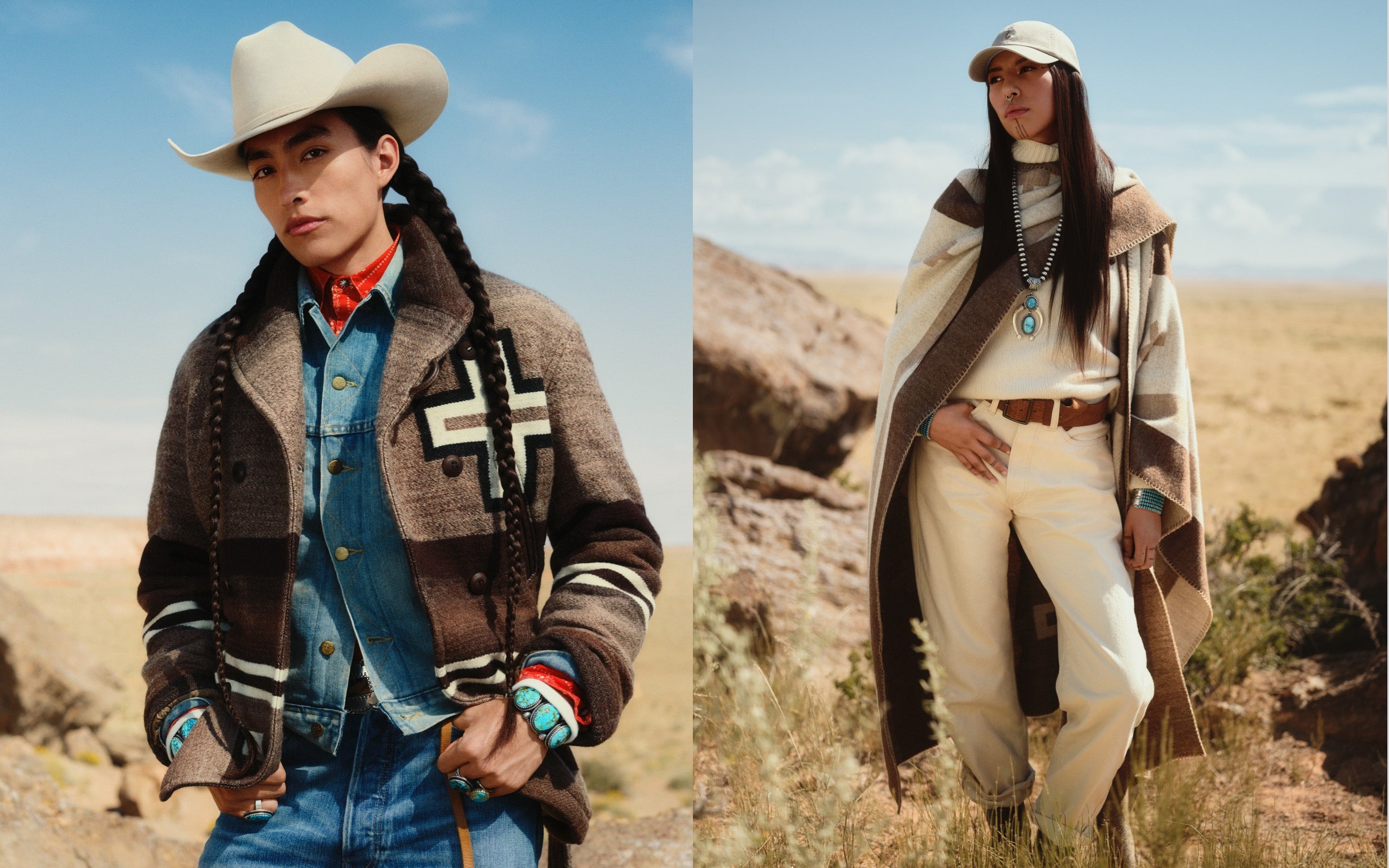
Polo Ralph Lauren x Naiomi Glasses, the inaugural collaboration for the Ralph Lauren Artist in Residence program, honors Navajo heritage and centuries-old wearing traditions
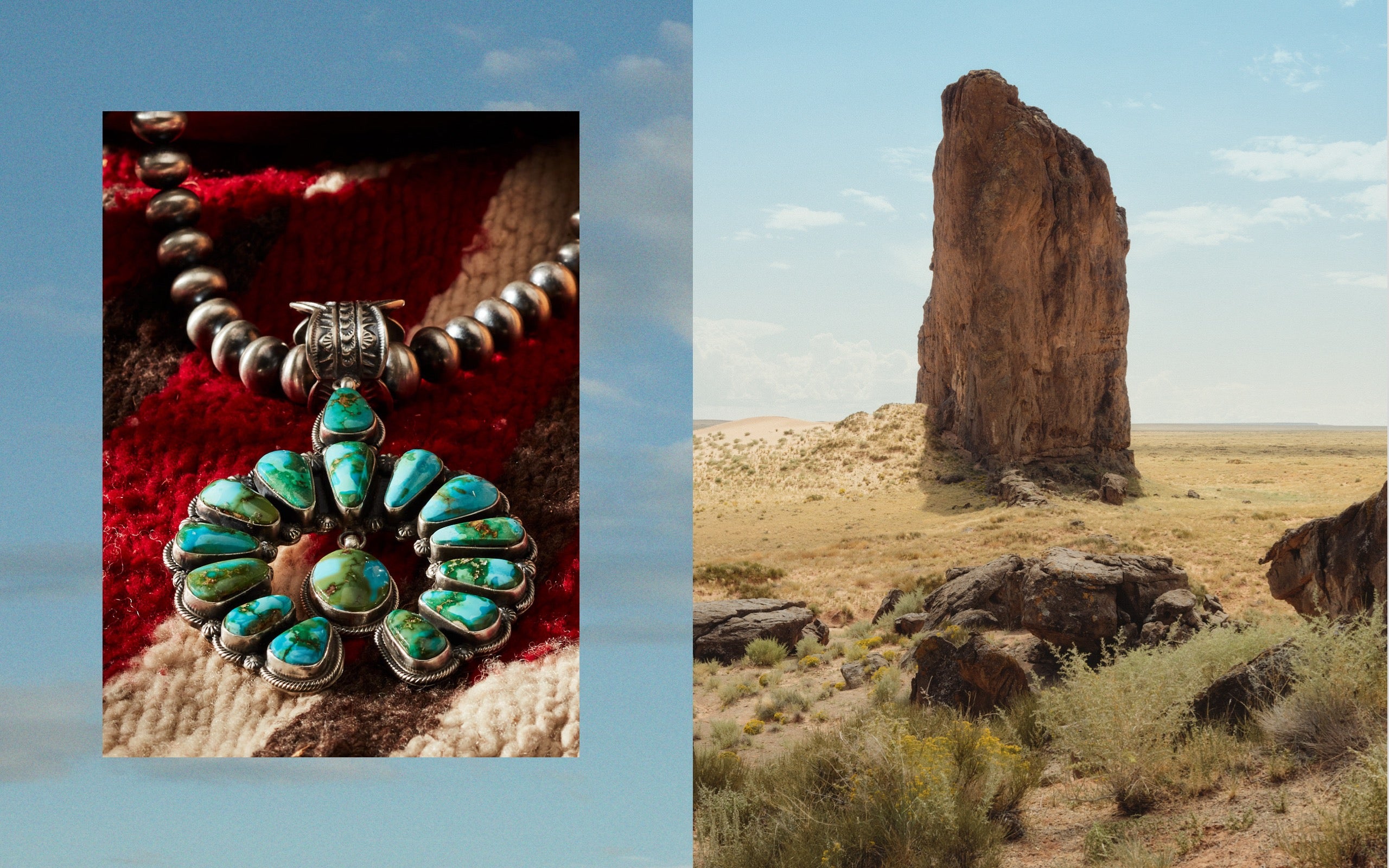
Polo Ralph Lauren x Naiomi Glasses, the inaugural collaboration for the Ralph Lauren Artist in Residence program, honors Navajo heritage and centuries-old wearing traditions
To Native jewelers in the Southwest, jewelry is both a historical anchor and a visionary bridge, connecting the past and the future through timeless designs. The majority of these master jewelry artists reside, at least part-time, on the lands of their ancestors. They propel traditional wisdom into the contemporary fine art world, preserving their familial legacies while inspiring the world with top-tier artistry and craftsmanship.
Naiomi’s passion for jewelry started during visits to local trading posts with her late grandmother, Nellie Glasses, and brother, Tyler Glasses Jr., both notable and respected textile artists. It was during these excursions that Naiomi and Tyler first discovered many of the artists now featured in her collection. Naomi drew strength and inspiration from these memories while curating the jewelry assortment featured in this campaign.
In a world where art and tradition are intrinsically intertwined, purchasing directly from artists is not just a transaction; it’s a form of support and appreciation. Authentic Native jewelry sustains long-standing traditions, supports an artist’s livelihood, and celebrates the truly artistic spirit of the American Southwest.
The Charleys (Navajo)
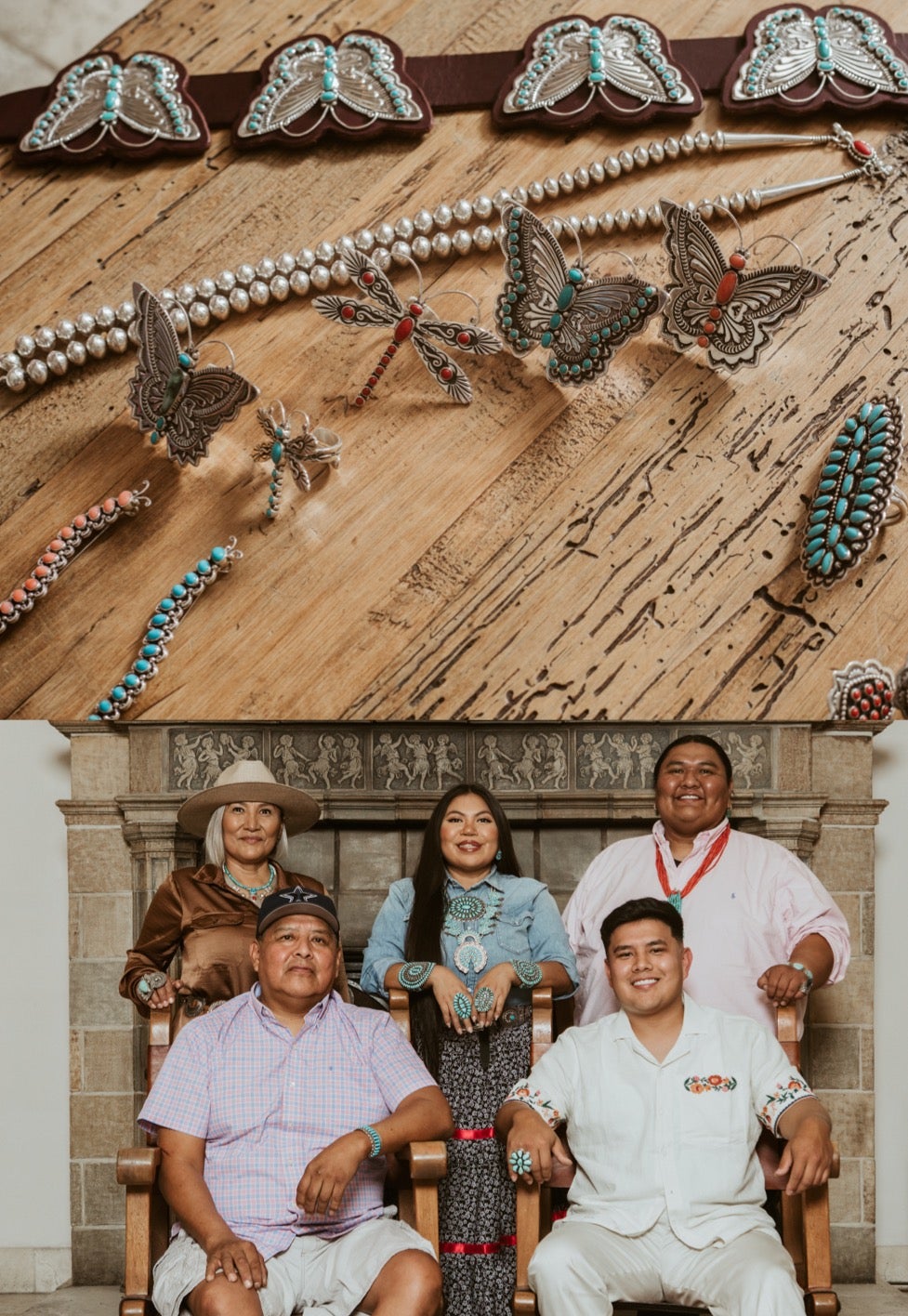
Lee Charley’s career in fine jewelry began at a young age under his mother Nellie Charley’s guidance, reflecting the strong family ties inherent in Navajo silversmithing. He’s renowned for ultraclean stampwork with a mirror-polish finish and whimsical creations inspired by nature, mainly featuring animals and insects.
His work caught Naiomi’s attention when she found a unique silver and turquoise caterpillar pendant at the Ellis Tanner Trading Post in Gallup, New Mexico. As she delved deeper into Charley’s work, she was impressed by the fine stampwork and unique subjects of his designs such as butterflies, ants, dragonflies, and lizards.
As a fifth-generation silversmith raised on the Navajo Nation, Lee’s son Matthew is deeply connected to Navajo history and culture. His pieces are characterized by heavy-gauge silver and gold with an elegant and contemporary twist on traditional styles. Much of his work prominently features a single, beautifully polished cabochon of high-grade turquoise as a centerpiece.
Matthew takes immense pride in being a collaborator with his father, furthering their shared commitment to preserving their cultural heritage.
The Listers (Navajo)
In 1969, David Lister, a Vietnam veteran carrying the enduring marks of service, returned home. Grappling with PTSD and bearing the loss of his lower left leg taken by a landmine during service, he embarked on a journey of healing after meeting his wife, Alice. Together, they decided to learn silversmithing, which became a very powerful and therapeutic outlet.
Alice’s love for jewelry was long nurtured by her family, symbolized by a cherished squash blossom necklace gifted from her father to her mother. As her mother aged, she encouraged Alice to replicate the necklace. Alice crafted a version using heavyweight materials and high-quality stones. This cherished item became a symbol of the family’s philosophy, becoming integral to their approach to jewelry: combining purposeful design with superior materials.
While visiting a trading post with her grandmother, Naiomi was awestruck by an Alice Lister piece featuring fine silver filigree. She was immediately determined to learn more about the artist, which led to a connection with Alice’s daughter, Davida Lister, through social media.
Davida started her journey as a jewelry artist in 2012 specializing in beaded necklaces. She employs heavier gauges of silver and her love for colorful stones is evident in her exquisite arrangements featuring red coral, orange spiny oyster, purple spiny oyster, and various shades of turquoise. Davida’s artistic palette is a harmonious blend of vibrant color theory and unique arrangements, ensuring each piece is an inspiring signature representation of her work. Through their friendship, Naiomi soon discovered that Davida is the sister of Dee Nez and Clarissa Hale, both esteemed jewelry artists whom Naiomi also holds in high regard.
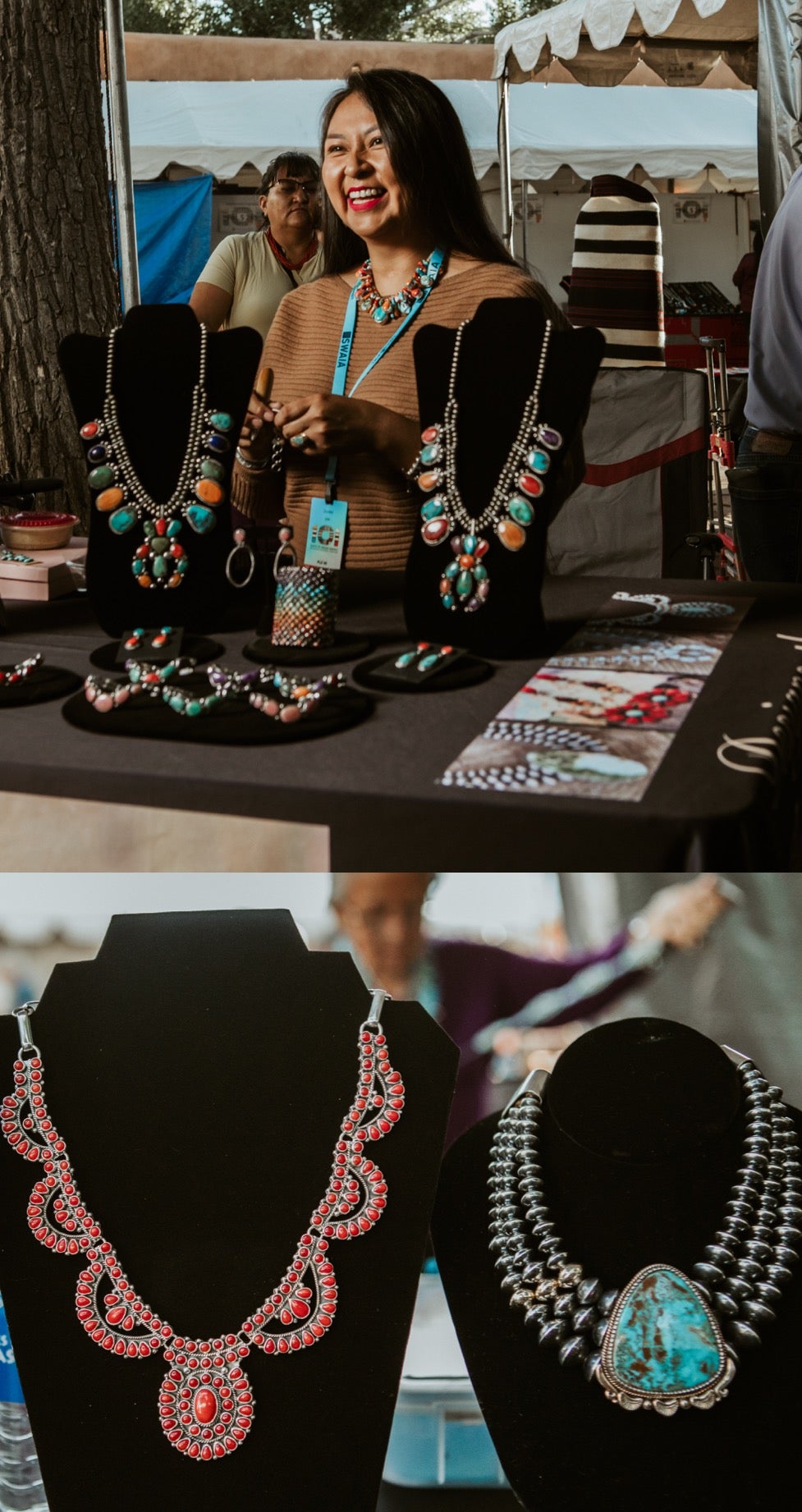
Born as her parents Alice and David first embarked on their silversmithing journey, Dee is the second-oldest sister of seven daughters. She played a pivotal role in shaping her younger sister Davida’s artistic path, offering meaningful guidance to this day. Known for its quiet precision, Dee’s work is a testament to the exacting standards she honed alongside her parents in their family workshop in Dilkon, Arizona. In Dee’s hands, Sleeping Beauty turquoise and Mediterranean coral often transform into exquisite bracelets, several of which have found their way into Naiomi’s collection.
Echoing Naiomi’s trips to the trading posts with her grandmother, Clarissa fondly recalls the 1970s and ’80s when she would accompany her grandmother on selling trips to Utah, Phoenix, Sedona, and the Grand Canyon. Her grandmother was also a weaver and a savvy business woman, even in her older years. Through observation, Clarissa learned the art of negotiation and trade.
Naiomi’s chance encounter with Alice’s work and her subsequent friendship with Davida revealed deeper layers of admiration and a story of resilience and craftsmanship. Their journey underscores the powerful influence of art, serving as both a personal catalyst and a bridge between generations.
Leon (Navajo) and Valerie (San Felipe Pueblo & Zuni Pueblo) Martinez
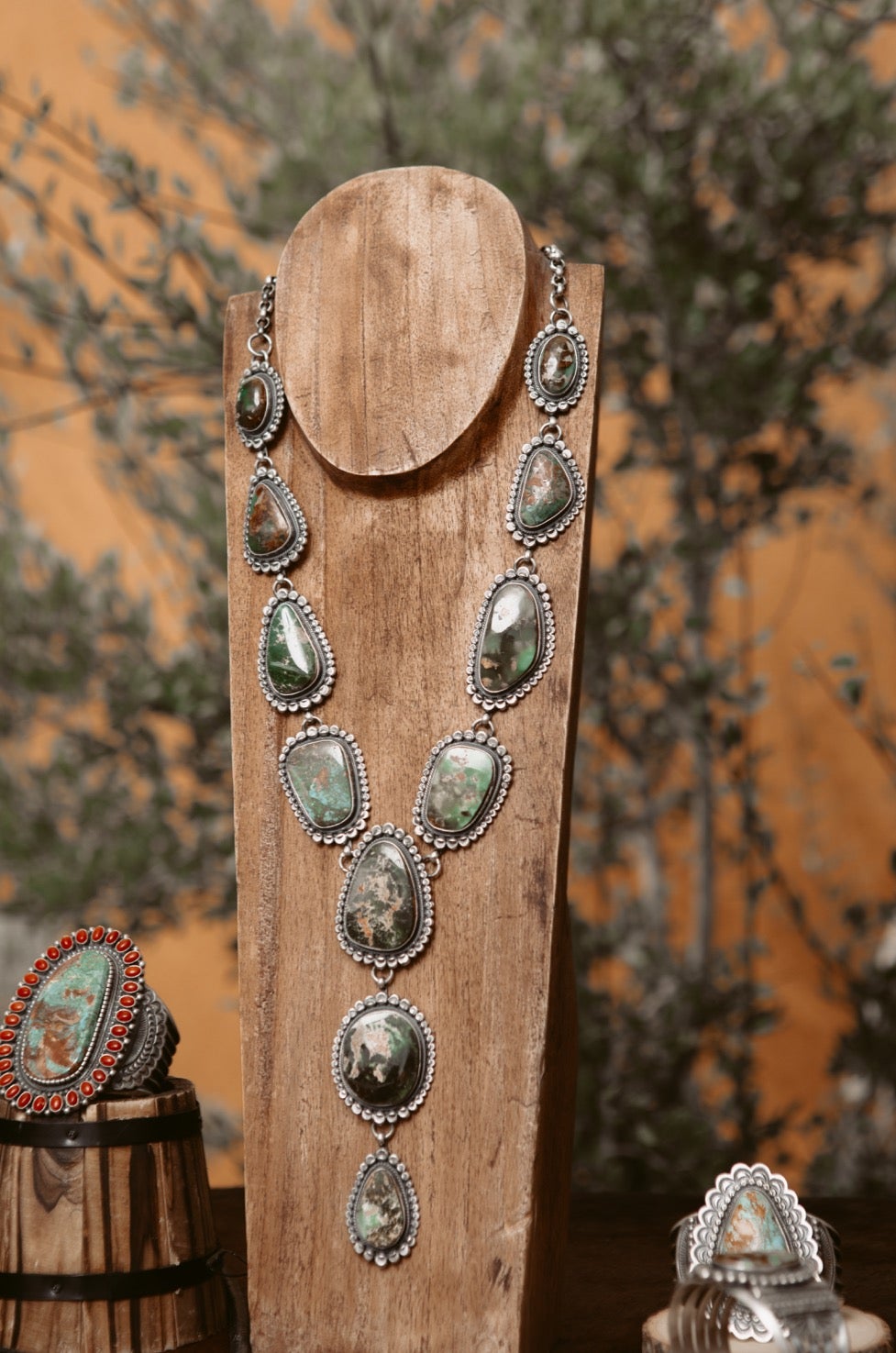
Leon Martinez started out in the 1970s helping his parents buff silver. Born into modest beginnings in Prewitt, New Mexico, it was through the art of silversmithing that Leon found his calling. With dedication, he mastered old-style Navajo designs, and today, together with his wife, Valerie, they continue this tradition with purpose.
Over the years, their collective dedication and quest for perfection in every piece have won them accolades. Most recently, they earned the coveted first place at the 34th Annual Totah Festival & Indian Market in Farmington, New Mexico.
At the Santa Fe Indian Market in 2021, their paths crossed with Naiomi and they praised her for being a good role model to young Indigenous people. “We had been following her journey on Instagram,” Valerie says. “I told Naiomi that she was an inspiration, especially to our niece’s baby girl, born with a cleft palate. To us, Naiomi is a beacon of hope, a gift from God.”
Leon and Valerie’s collections are a harmonious blend of old Navajo vintage and contemporary styles. Every piece resonates with authenticity. The turquoise they incorporate is sourced from respected mines located in Nevada, Arizona, New Mexico, and Colorado.
“At the heart of our creations is ethics," Valerie says. “For us, it’s about preserving the history of authentic Native American jewelry and art.”
Ernest and Readda Begay (Navajo)
Bread Springs, New Mexico, serves as the backdrop for Ernest and Readda Begay’s jewelry studio. These award-winning artists create traditional Navajo jewelry that tells a story of family heritage and traditional design techniques.
Readda specializes in half-cluster rings, refined through the observation of her family of accomplished jewelers, including her grandfather, uncles, and aunts. Her craftsmanship extends to a variety of unique pieces, including cuffs, earrings, necklaces, and pendants, each graced with flawlessly shaped cabochons of semiprecious stones.
Ernest is renowned for his distinctive old-style clusterwork and handcrafts his own tools. As an expert in cutting and shaping stones, he is known for creating impressive pieces such as concho belts, bolos, bow guards, heavy-gauge bracelets, large pendant rings, and squash blossoms. Naiomi met Ernest at the annual Navajo Nation Fair, sparked by mutual artistic admiration. Ernest then introduced Naiomi to Readda and her admiration of their commitment to techniques passed down through generations grew even deeper.
Ernest, with his 40-plus years of experience, and Readda, a third-generation silversmith, take pride in not only their finished products but also in the process of creating them—each hammer, each buff, echoes their values.
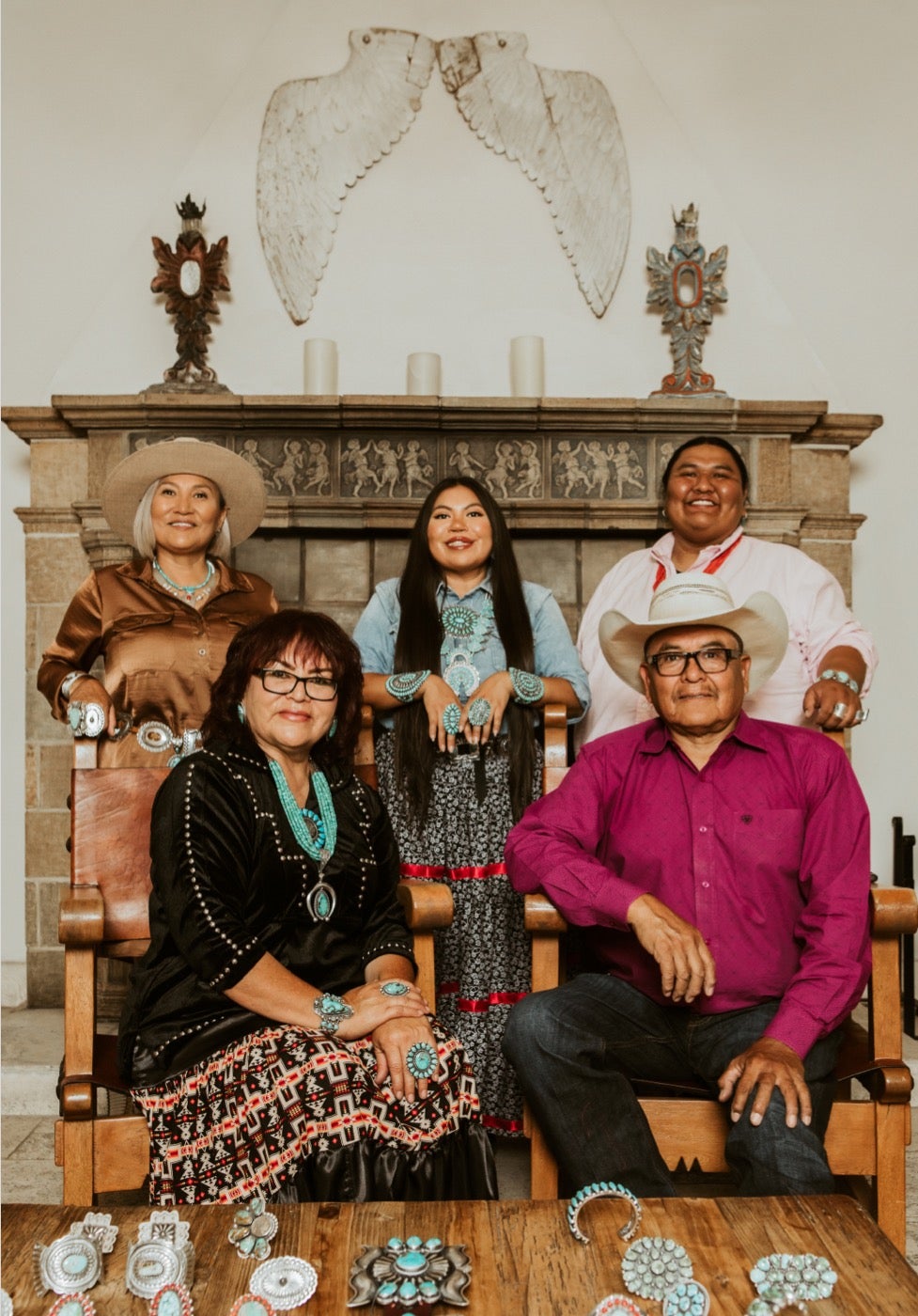
Their jewelry, inspired primarily by the unique characteristics of natural materials like turquoise and shells, serves as tangible narratives of imagination, effort, and love. By ensuring no two pieces are alike and by passing down their creations to the next generations, they emphasize the importance of preserving heritage and culture, and the joy it can bring to people across diverse communities.
Piki Wadsworth (Hopi, Navajo, and Anglo)
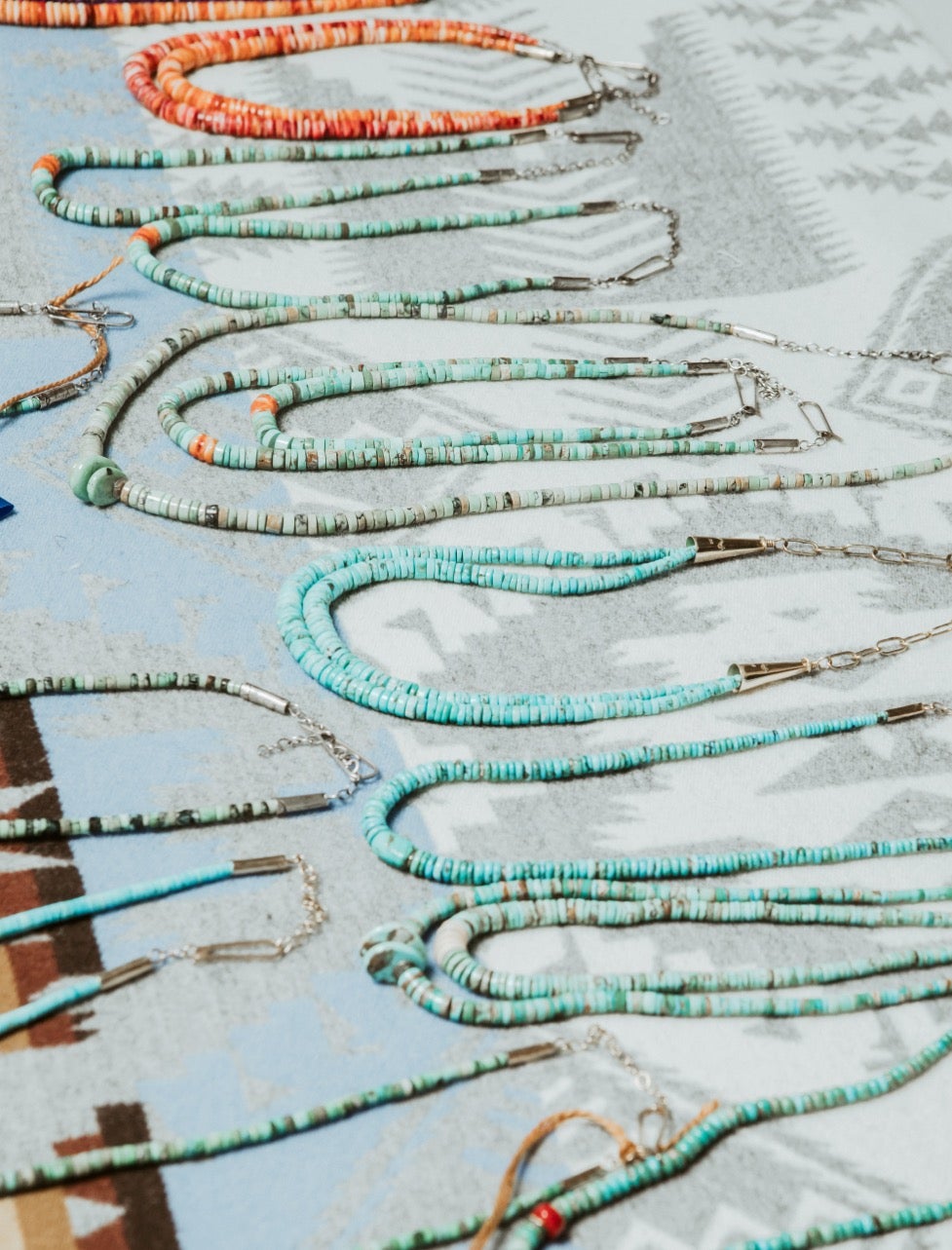
Piki Wadsworth was born on the Second Mesa in Hopi Pueblo and she is the daughter of celebrated jewelers Cheryl Yestewa and Glenn Wadsworth. Growing up as the third of nine siblings, Piki had a childhood that was immersed in the rich traditions of jewelry-making. Her journey began at a tender age; by the time she was 10, she was already drilling and stringing beads for her parents.
As the sole heir to her mother Cheryl Yestewa’s cherished legacy, who was famous for crafting stunning handmade turquoise beads, Piki has embarked on her own artistic path, rapidly ascending to prominence as one of the most exceptional bead-makers in the Southwest. She exclusively uses non-treated natural stones, a testament to her unwavering commitment to upholding traditional techniques.
Piki’s jewelry creations are a meticulous homage to time-honored practices, with a design philosophy that captivates Naiomi. Piki’s work embraces elegance and simplicity, allowing the innate beauty of the stones to shape her creations. Despite her extensive turquoise collection, Piki remains irresistibly drawn to its enduring inspiration, a connection that guides her jewelry and artistry.
Philander and Isiah Begay (Navajo)
Isiah Begay, a fifth-generation jeweler from Round Rock, Arizona, emerged as a promising talent when he was just 12 years old, securing a second-place ribbon at the Navajo Nation Fair for the first piece of jewelry he ever made.
Isiah specializes in fine inlay and heavy-gauge tufa casting, often choosing gold as his preferred medium. His journey began with learning tufa casting from his father, Philander Begay, a renowned contemporary jewelry artist. He eventually carved his own path by developing a unique approach to lapidary inlay. He is a master of cornrow inlay, a meticulous style demanding precise alignment of precious stones into delicate rows. Isiah’s artwork frequently showcases high-grade turquoise, Australian opals, coral, sugilite, and eye-catching 18K gold accents.
Through his craftsmanship, Isiah shares the values and principles upheld by his family. His creative philosophy is straightforward yet profound: “Never cut corners and always strive for improvement.” It’s a message he embeds in each jewelry piece, hoping it inspires those who adorn themselves with his creations.
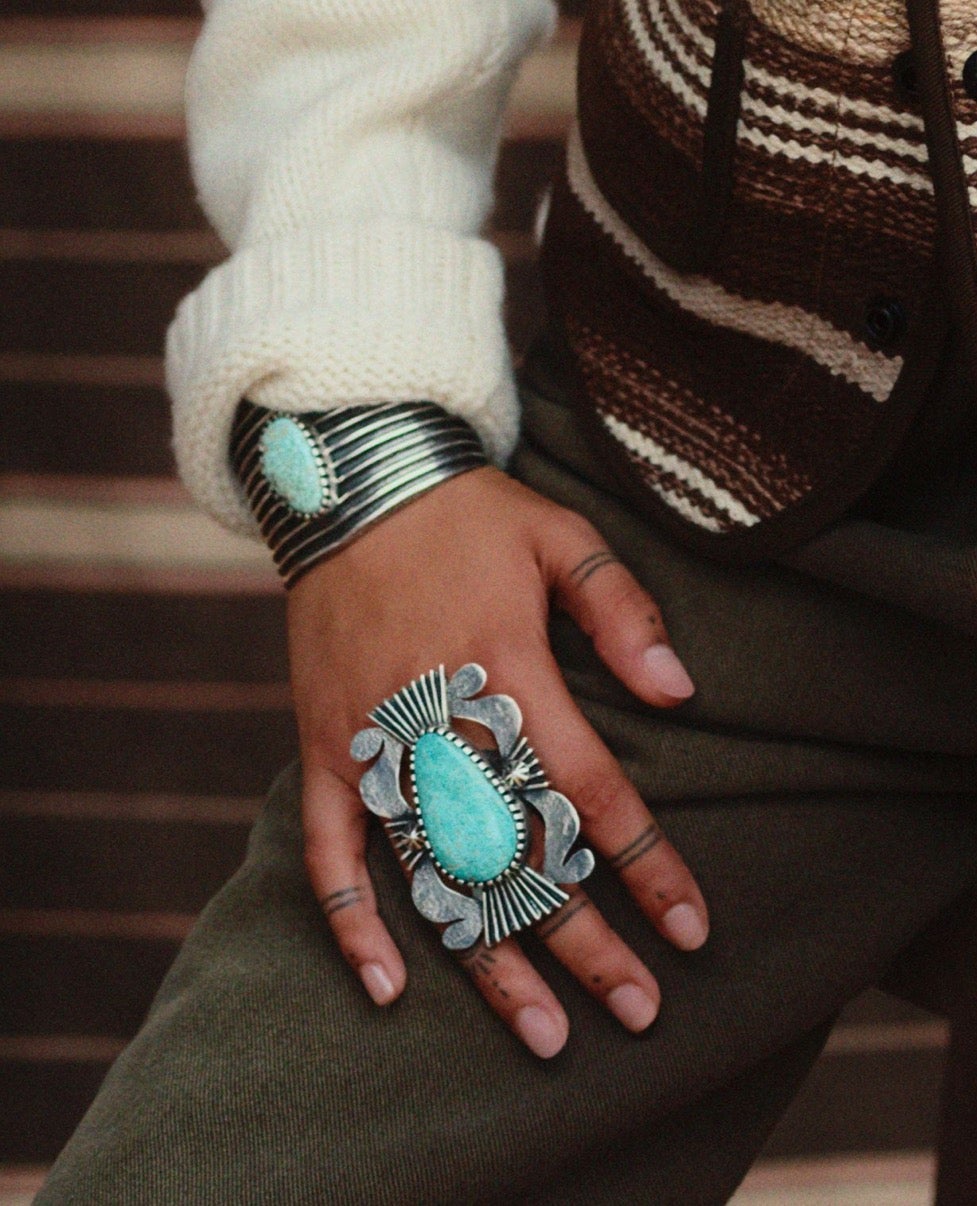
In 2020, Isiah crossed paths with Naiomi at the RC Gorman Gallery in Scottsdale. Impressed by the sophisticated craftsmanship of his gold jewelry, Naiomi inquired about the artist behind the work. Discovering that Isiah, then only 19 years old, had been creating such luxurious pieces came as an impressive surprise to her. She found his dedication to quality and artistry deeply resonant, leading her to become an avid collector of his works.






